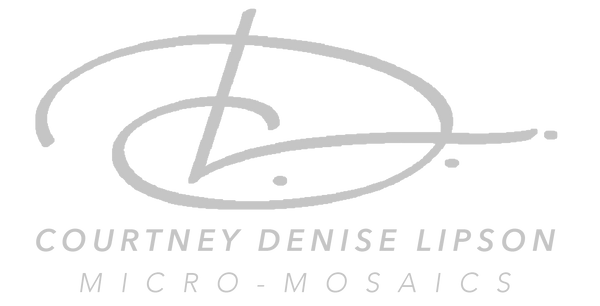When we quantify a lifetime in the largest context of time, it seems as though we are but a mere drop in a vast sea. What we decide to do with our time ripples outward in ways we will never truly fathom...imagine the universe as a milky way of individual lifetimes: timelines overlapping, intersecting, and dissolving.
The Century Project is the largest micro-mosaic I've worked on to date. It was also one of the most impactful projects I've been a part of.
A few years ago, during a Stonington Gallery opening, I was speaking with visionary, Stephen Friend, who asked me if I had ever considered doing larger scale micro-mosaics. My jaw dropped because that was something I had actually been thinking of, but hadn't figured out how and when I'd slip it into my schedule. After a split second, I picked my jaw up off the ground and smiled. "Why yes, I have wanted to do something larger than jewelry, but the right idea hasn't shown itself yet." So he began to describe The Century Project.
At that time, Stephen was nearing fifty and had reached a point of introspection. He wanted to commission a meditative piece of art that would represent his past, and serve as a tool for visualizing his future. As if this man hasn't done enough remarkable things in life, I could tell he wanted this project to help him maximize the rest of the time he is given.
Stephen shared with me that he takes time nearly each year to commission art in collaboration with his ideas. I saw some of the past work on display in his home and realized that part of each journey is intentionally meant to help an artist he appreciates. What an honor to be an artist asked to do something so impactful.
For the Century Project, Stephen was thinking on a scale somewhere between 7-10 feet long, and maybe 1-2 inches high. Because it was so long and narrow, he wanted some kind of backdrop--bringing in another artist to collaborate--so that it wouldn't get lost on a wall in his home.
Discussion went this way and that; several possibilities of representing his life in a timeline, and whether or not it should be interactive. How he would use it in his daily meditations, how it would impact his physical space was somewhat fluid, while the predominant backbone remained: Stephen's life would be interpreted in a micro-mosaic.
The hardest part was up to Stephen. He needed to condense his life story somehow so that he could tell me the facts, the highlights, his journey, in such a way that I would be able to interpret it into a visual "painting". He started the timeline ten years before his birth and projected forward into the future to age 90, hence the title. I asked that while he wrote, he make notations on memories which call up his senses--color, pattern, flavor, scent, sound--things that influence and enrich his story in a visceral sense.
In preparation, Stephen told me he'd be taking down notes, trying to distill his ideas into something he was comfortable sharing. This first step--organizing the method of conveyance from Stephen to me--would guide the entire project. It helped organize my design in ways we wouldn't understand until much later. While Stephen kept up an incredible schedule, hopping from continent to continent for the formation of his non-profit, Sage Bionetworks, he was writing down notes on ten sheets of plain white paper. On airplanes, in hotels, at home and office he scrawled sections of his life down in linear format--in a three layer graph of sorts.
Stephen divided his life into segments with themes, and for each segment, was able to differentiate between his emotional and spiritual journey, his actual physical path, and the facts surrounding where he was and what he was doing, including the people and places important to him. He chose an album of music to listen to while he wrote. This took him nearly a calendar year to complete; Stephen was working on this project in-between the lines of a very demanding schedule.
When it was finished, Stephen and I, (along with his wife, Diana, and my husband, Scott) met in person to go over in greater detail the ideas he'd put down. One thing I knew about Stephen and Diana at this point was they are very private individuals. I remember thinking what a huge step it is to decide to share information of a personal nature with a virtual stranger, and the scale of what we were doing was going to demand quite a bit of openness on both our parts. As I waited for this moment I had not allowed myself to imagine the end result of this project. I didn't want my ego, my self, my creativity to push what he was about to share with me in any direction. I wanted this process to draw me into it, so that my skills and talents would be an expressive tool. I emptied my head and the four of us sat down for three hours while he told me his story, using the ten sheets of paper to guide us.
As he spoke, I looked at the paper with his handwriting interspersed with doodles, things underlined, words undulating in patterns, and began to see the Century Project in full color in my mind. He was handing me the embers of his life to inspect and weave into an image.
I immediately spent the next two days drawing up a draft; one day in pencil and another day spent using color and texture to create themes and symbols for the patterns of Stephen's life. When finished, we met again and the only change he suggested was when he gave me a small handful of rocks--rough gems that he'd picked up here and there: two diamonds in the rough, a couple of tourmaline slices, an amethyst pyramid. He asked that if I found places to incorporate them into the design, to please do so, but that it was not imperative. I ended up finding places for each one, and adding some of my own as markers for milestones and important moments.

Our sketches: from linear graph to color imagery.

Test piece of a section of the project. Because of the length we explored substrate materials and whether or not seams would be necessary. Alan Rosen came up with a solution to eliminate seams.
Stephen asked me to only contact him with words from that point on. He didn't want to see the piece in progress, but he'd appreciate my thoughts as I went. I spent the next three months beading the 100" x 2" micro-mosaic, each day re-living a portion of Stephen's life, mourning his losses, and finding joy in his happiness. I listened to the music he'd chosen to write by as I worked. There were days that I wanted to re-write for him--to give a positive outcome--and those days were heavy to bear. Other days were so incredibly happy; at this point, I had met Stephen's wife and children, so I was able to conjure them as I worked. Every bead was laid with intention, every inch of micro-mosaic represented a year of Stephen's life. It was truly mindful work to delve into a life outside my own.
The day Stephen visited our studio to see my part of the project completed, he arrived with his iPod set to the music he'd listened to as he wrote. He turned on the iPod as I unveiled the micro-mosaic. That day was a celebration of another step in life, and only part of the project was complete. We talked about all of the wonderful coincidences that had popped up thus far, and discussed where to take the rest of the project--how to frame it and what the backdrop would look like.
It was another year before the Century Project was complete; there were many components to draw together, including a trip to Microsoft to meet with Curtis Wong who helped create the backdrop image. It is a composite of photographs taken from telescopes around the world, combining solar systems, nebulae, and constellations in a complementary array of imagery to the timeline. Furniture-maker, Alan Rosen, built a gorgeous walnut frame for the micro-mosaic. A transparent image and lightbox were created for the backdrop--it was designed so that there would be a light on the micro-mosaic and a backlight on the night sky that could be dimmed or turned off depending on the ambient light in a room. Diana Friend helped to engineer the parts into one unified display. The Century Project was exhibited for a short time at the Stonington Gallery in Seattle, WA and is now permanently displayed in the Friend's home.

Occasionally, I receive an email from Stephen: a photograph of a portion of the Century Project, with a short observation or hello to accompany it. He is an early riser and I know that I am hours behind him as he makes his way through the day. I smile as I head into the studio to pick up beads and tweezers, adding a bit more color to the world.


